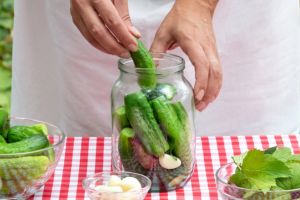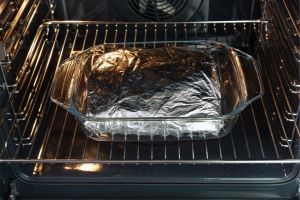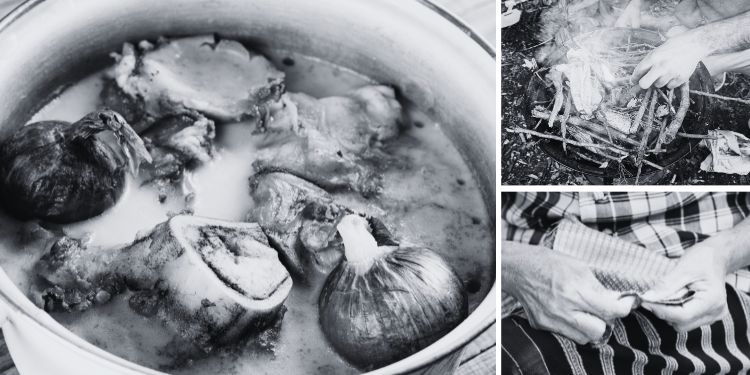During the Great Depression, when times were unimaginably tough, people relied heavily on repurposing household items to survive.
Prepping today draws upon this resourcefulness, as the ability to creatively reuse what you already have can be invaluable during any crisis or SHTF situation.
In this article we want to dive deep into some specific items repurposed during the Depression era and how modern preppers can apply these ideas.
Clothing and Fabric
Clothing wasn’t just something you wore—it was a versatile resource. Clothes were repeatedly mended until they could no longer be repaired. Once garments were beyond use, they were transformed into quilts, rags, or even clothing for children.
Flour sacks, for example, were a lifeline for many families. Manufacturers began to print pretty patterns on them as people increasingly used the sacks to sew dresses, aprons, and curtains.
 In today’s context, being able to sew and patch up clothing is a survival skill worth learning. Instead of throwing away torn clothes, preppers can learn to repurpose fabric for practical uses—whether for insulation, bandages, or makeshift bags.
In today’s context, being able to sew and patch up clothing is a survival skill worth learning. Instead of throwing away torn clothes, preppers can learn to repurpose fabric for practical uses—whether for insulation, bandages, or makeshift bags.
Fabric from old sheets or shirts can be cut into bandanas, scarves, or masks.
In the same vein, learning how to make quilts from worn-out clothing can provide warmth in colder weather climates.
Old Tires
In the 1930s, old tires were more valuable than one might think. People often repurposed car or bicycle tires to create durable shoe soles.
This was especially common in rural areas where sturdy footwear was needed for farm work and other manual labor. The tough rubber provided much-needed protection for feet at a time when buying new shoes was out of the question.
⇒ Backyard Projects That Might Get You Arrested
Today, preppers can look at old tires through the same lens. Tires can be cut into pieces and used in a variety of ways, like for insulation, heavy-duty flooring, or even building structures in off-grid homes.
While rubber tire sandals may not be needed in every situation, the concept of using old materials for new, unexpected purposes is still highly relevant.
Canning Jars and Food Storage
 Food storage was a crucial part of surviving the Great Depression, and canning jars played a central role.
Food storage was a crucial part of surviving the Great Depression, and canning jars played a central role.
People reused canning jars over and over again for storing not only food, but also household items like screws, nails, and even small tools. Tin cans were another resource often repurposed.
Once the food was gone, these cans became lanterns, scoops, or even children’s toys.
Modern preppers who practice home canning can take inspiration from this. Empty canning jars can serve multiple purposes—like organizing seeds for gardening or even turning into makeshift drinking cups or vases.
Old jars can be reused for fermenting vegetables or as containers for storing dehydrated food long-term. Similarly, knowing how to use empty cans for simple DIY tools (such as a scooper for grains or small planting pots) can reduce waste.
Furniture and Wood Scraps
When furniture became too worn out to use, it wasn’t thrown away—it was dismantled for firewood or to make small repairs around the house. Scrap wood was used for everything from patching up homes to building new structures, such as sheds, chicken coops, or storage boxes.
Today, as lumber prices rise, knowing how to salvage old wood is a valuable skill for any prepper to have. Wooden pallets or discarded furniture can be repurposed for raised garden beds, firewood, or emergency repairs to shelter.
Knowing how to safely break down larger wooden items and store scrap wood can help provide a ready supply of building materials in a crisis. But make sure to never burn or work with these types of wood that are common, but poisonous.
Animal Bones and Hides
 During the Great Depression, bones were boiled to make broth, which served as a nutritious base for many meals.
During the Great Depression, bones were boiled to make broth, which served as a nutritious base for many meals.
Related: How to Can Bone Broth
Once the broth was made, the bones were often dried and ground up to make bone meal, which was used as a fertilizer.
Animal hides were used to make clothing, blankets, or even rugs.
In a long-term survival situation, these practices can be essential. Knowing how to utilize every part of an animal, including the bones and hides, is a skill preppers should familiarize themselves with. Not only does this minimize waste, but it also provides additional food sources and materials for making tools, clothing, and insulation.
Glass Bottles and Jugs
Glass bottles and jugs were valuable commodities. Rather than being tossed, they were washed out and used to store liquids, like water, milk, or homemade vinegar. Large jugs became flower vases, and smaller ones were sometimes turned into oil lamps with the addition of a wick.
Glass containers are still a staple in many prepping kits today. They can be used to store clean drinking water, make homemade cleaning solutions, or ferment food like pickles and sauerkraut. Knowing how to safely repurpose glass bottles for multiple uses can help preppers cut down on waste and make the most out of limited resources.
Tin Foil and Metal Containers
 Even the smallest scraps of metal were repurposed. Tin foil was reused over and over again—flattened out and saved for later use in cooking or wrapping food.
Even the smallest scraps of metal were repurposed. Tin foil was reused over and over again—flattened out and saved for later use in cooking or wrapping food.
Metal containers, such as old coffee cans or biscuit tins, were turned into toolboxes, storage containers, or even small stoves for heating food.
For preppers, metal containers are particularly useful because they can be used to store items securely, protect perishables from pests, or even shield electronics from EMPs.
Repurposing metal scraps, just as Depression-era families did, is a critical skill when living off-grid or in a long-term survival situation.
Newspapers and Magazines
Paper products were far too valuable to waste. Newspapers were often repurposed as insulation to keep homes warm during cold winters. They were also used to line drawers, wrap food, and even as toilet paper when supplies ran out.
Magazines, once read, became makeshift wrapping paper, padding, or were used for crafts such as papier-mache, or as you may know it paper mache.
 Preppers can apply these same concepts by saving newspapers and magazines for similar uses.
Preppers can apply these same concepts by saving newspapers and magazines for similar uses.
In addition to insulating windows or walls, paper can be shredded for kindling.
Related: The Only Survival Fires You Should Know
During an emergency, when modern conveniences are unavailable, having a stack of old newspapers or magazines could be invaluable for everyday tasks like starting fires, packing food, or creating makeshift insulation.
Lessons From the Great Depression for Preppers Today
The Great Depression showed us that with creativity, almost anything can be repurposed.
Learning these skills now can help preppers not only survive but thrive in a crisis.
By seeing the potential in household items most people would throw away, you’re one step closer to self-reliance.
In today’s world, where resources could quickly become scarce, the ability to repurpose what you have on hand is invaluable.
You may also like:
 The Worst States for Living Off Grid
The Worst States for Living Off Grid
Household Items You Need to Stock Up on Before the Upcoming Great Depression (Video)
How to Make Your Immune System Stronger















Yeah you can make some The Ho Chi Minh sandals from old tires and sell or barter them. Maybe a big hit in the hotter climate states, not so much in the colder states during the Winter’s snow, but good idea.
How many books do we preppers need to survive, there is a book ad lately in practically every posted article?
Which book would be the one to take if we had to bugout?
Too many heavy books to carry on foot and forget storing them on a smartphone that can get damaged or lost.
Well like any business you have to make some money to keep this website up and running. We are posting or commenting on articles posted for free.
It takes money to run a business, even if you don’t care for too many books.
Actually I have a couple of the books, plenty of jam packed information in a book than trying search the internet for the same information.
I’m already ahead on these except the tires. To use them for insulation and flooring is a really good concept. You have to pay to get rid of them anyway so, why not put them to good use.
When my boys were young, I took a large tractor tire and made a sand box out of it. They loved it and played in it every chance they got. Of course, I had to make a plywood cover so the cats wouldn’t use it. My neighbor paints them and plants flowers in them for her bees. Great read for the day! Thank you, Matt
If the internet goes down, some of us may wish we had a lot more in terms of hard copy, for useful information on so many subjects.
Always entertaining or better described as information gathering opportunity. People vary on likes or dislikes but this site provides a wealth of information. Hard copies always will be the main stay for older people of which I am one however power to run most electronics may become scare or non existing depending on “What really happens going forward” Currently we have a choice of how we gather/collect/store information “BUT” all of that can change in the blink of an eye or EMP. My comment is “You are doing a bang up job and we all should be thankful – well done!
Hi Samantha, you can get the PDF versions of the books and put them on a kindle for future reference. It doesn’t take much power to keep a kindle going. One can use a charger powered by batteries or solar power, Use a pen and paper to take notes of those things you do regularly until you know them so you don’t have to keep turning the kindle on to conserve power.
I understand what you are saying, I thought the same, but decided to think in terms of solutions.
You are supposed to read them, study them, practice BEFORE it’s all in the fan. If you’re waiting and then try? It won’t matter if you have a dedicated book wheelbarrow. You, are in trouble. Like I say often.
Have your soul prepared first.
I’m amazed that (almost all) young adults and kids purposely do nothing about reusing things.
Good article. As a 70-year-old my parents and grandparents were a wonderful resource for being able to do things like described here. My friends kid me about straightening bent nails But it’s relaxing.
I had a friend who as a child during the depression used to have to drink out of soup cans because they couldn’t afford cups or glasses.
i remember my grandma having a drawer for nothing but folded up aluminum foil sheets. she reused them over and over. i cut up a half-gallon milk jug and use it for a bird seed scoop through-out the winter season. i have 2 or 3 bundles of milk cartons hanging in a shed for use as needed. being a pack-rat sucks sometimes but sure comes in handy as well.
as a rat pack myself- who here has carried a load of junk to a landfill only to come home with more than we left with. : )
re-use, re-claim and re-purpose.
my wife says that i’m stingy, no i’m thrifty.
Example: Harvested mullein this last week. I used every single part of the plant. Including the roots. I made several different medicines, tinder, kindling and even put a few leaves in my shoes to help with achy tired feet. I didn’t used to think like this or live like this. Everything I look at now has a use, better yet, how many uses and how many ways. It’s a way of looking at life and living it. What we have been given by our creator… not big tech, etc. They have shifted our focus away from real living and thinking.
The Indians taught the pioneers to use the Mullein leaves
as toilet paper.
old tin cans can be used to collect maple syrup in the north and pine sap in the south. pine sap has many uses such as glue and is a great firestarter and a wound sealer.
drill a hole in a tree. nail a can under any one and enjoy the benefits. like traps, you don’t have to babysit them.
best of luck all. knowledge is power